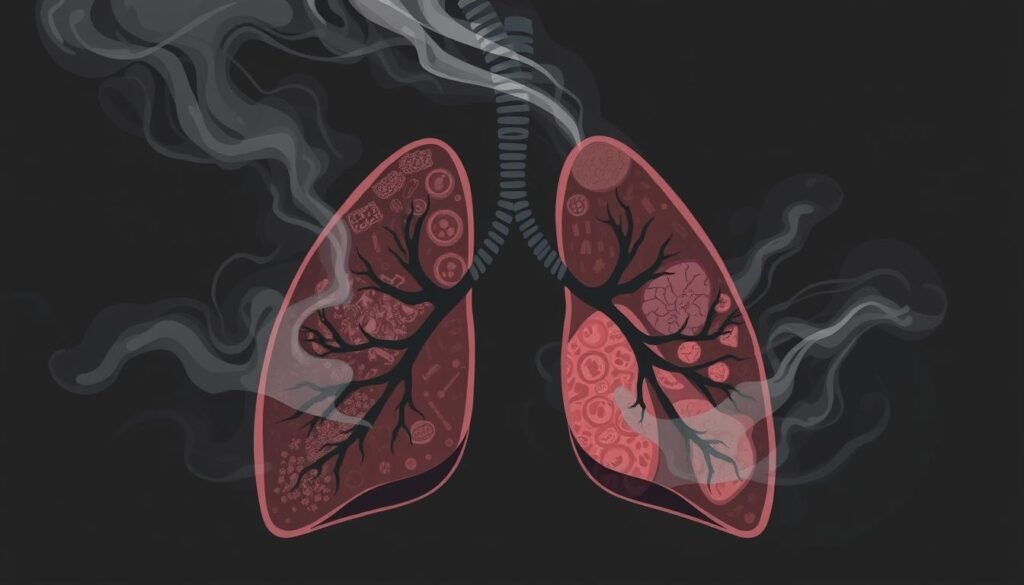About 19.78% of U.S. adults are smokers. This number shows how common smoking is. It also shows why it’s important to know about smoking duration and intensity. As people smoke longer, the health risks get worse. So, we need to study how long and how much people smoke. This helps us understand their health risks better.
Quitting smoking is hard for those who’ve done it a long time. The challenges of quitting depend on how long and how much a person smokes. We will look at what these terms mean. We will also explore their impact on health, life quality, and public health.
Key Takeaways
- The prevalence of current smoking stands at 19.78% in the U.S.
- Duration and intensity play crucial roles in assessing health risks connected to smoking.
- Smokers with longer histories may experience more severe health consequences.
- Understanding these factors can aid in developing effective smoking cessation strategies.
- Research emphasizes the importance of both duration and intensity in evaluating smoking-related diseases.
Understanding the Basics of Smoking Duration
Understanding how long someone has smoked is key to knowing its health risks. Smoking duration means the total years a person has smoked. This is important because it greatly affects health, increasing risks of lung cancer and COPD.
The Definition of Smoking Duration
Smoking duration tells us more about tobacco exposure than daily cigarette count does. Studies show long-term smoking, even if it’s not heavy, raises the chance of serious health problems. For example, research found that smoking duration could lead to more diseases in certain adult populations.
How Smoking Duration Affects Health Outcomes
The longer someone smokes, the more likely they are to get chronic diseases. This shows why stopping smoking is crucial. The connection between smoking years and diseases like lung cancer is strong. People with a long smoking history face higher risks of their lungs not working well. Studies have shown that smoking’s harm is tied more to how long you’ve smoked than how much you smoke.
| Smoking Duration (Years) | Health Risks |
|---|---|
| 1-5 | Minor health risks |
| 6-10 | Increased risk of respiratory issues |
| 11-20 | Significant risk of lung damage |
| 21+ | High likelihood of cancer and severe cardiovascular diseases |
Knowing the link between smoking duration and health risks is vital. It helps design public health efforts to lower tobacco-related illnesses.
The Impact of Smoking Intensity
Understanding how much and how often people smoke is key. The more cigarettes someone smokes each day, the worse it is for their health. This also means they’re more likely to get hooked on nicotine. Knowing how much a person smokes can help create better ways to help them stop.
Defining Smoking Intensity: Cigarettes Per Day
Smoking intensity looks at how often a person smokes, counted by cigarettes per day. Smoking a lot every day is risky and can lead to health problems and addiction. Studies show many smokers smoke enough daily to become strongly addicted to nicotine. Quitting can be hard without help.
Intensity’s Role in Nicotine Addiction
How much a person smokes is crucial in becoming addicted to nicotine. Those who smoke more often are more likely to struggle when they try to quit. They may feel strong cravings that make them want to smoke again. Research says that smokers who consume a lot have a hard time quitting due to this strong need for nicotine.
| Smoking Intensity | % of Smokers | Intention to Quit (%) | Impact of Price Increase on Smoking Less (%) |
|---|---|---|---|
| 10-19 Cigarettes per Day | 9.42% (Men) | 9.39% | 75% |
| 20+ Cigarettes per Day | Primary group | Challenging | Variable |
| 1-9 Cigarettes per Day | 2.04% (Women) | 2.04% | 5% |
The link between smoking a lot every day and addiction is clear. This shows the need for better public health plans. If we can focus on how much people smoke, we can come up with better ways to help them quit.
Duration and Intensity of Smoking: How They Are Measured
Gauging how long and how much someone has smoked is key to understanding the risks. Doctors use measures of tobacco exposure to figure out smoking’s effects. This helps assess the impact on a smoker’s health.
Pack-Years: Understanding This Common Measurement
Pack-years measure smoking by looking at how long and how intensely someone has smoked. If someone smokes a pack a day for 10 years, they have 10 pack-years. This measure helps show the risk for heart problems, COPD, and lung cancer.
Knowing the pack-years is crucial for catching diseases early. This can boost the odds of successfully quitting smoking. For more, check out this comprehensive guide.
Other Metrics for Evaluating Tobacco Exposure
Beyond pack-years, other measures like the total years someone smokes and their daily cigarette count matter. These stats flesh out a smoker’s history. This is vital for planning their treatment.
Studies show that the reaction to higher cigarette prices varies among smokers. Some quit or smoke less with price hikes. These insights help tailor efforts to cut down smoking rates.
Health Risks Associated with Smoking Duration
It’s vital to know how smoking affects health, especially if you’re thinking about quitting. Studies show that smoking for a long time greatly increases the chance of serious health problems. These include lung cancer and heart diseases.
Increased Risk of Lung Cancer with Longer Duration
Smoking for a long time can really up the risk of lung cancer. Research shows that nearly all lung cancer patients, about 95%, have smoked for more than 20 years. Even those who smoke a little each day are at high risk. For example, people who smoke ≤10 cigarettes daily are about 9.65 times more likely to get lung cancer. This highlights how dangerous smoking is, no matter the amount. Low-intensity smoking might seem less risky, but it still increases cancer risks.
Impact on Cardiovascular and Respiratory Diseases
Smoking’s dangers go beyond cancer. It’s strongly linked to heart and lung diseases. Secondhand smoke causes around 34,000 heart disease deaths in the U.S. each year. Smokers die at a rate three times higher than non-smokers. Even light smoking increases the risk of heart disease and breath-related illnesses.

| Health Risks | Statistics |
|---|---|
| Annual premature deaths due to smoking | 480,000 |
| Lung cancer deaths among nonsmokers from secondhand smoke | 7,300 |
| Heart disease deaths from secondhand smoke | 34,000 |
| Increased risk of lung cancer for smokers ≤10 CPD | HR=9.65 |
| Mortal risks among smokers compared to non-smokers | 3 times higher |
The Significance of Early Initiation of Smoking
Starting to smoke at a young age means big health risks later on. People who smoke before turning 20 face more health problems and can die sooner because of smoking. This shows why it’s so important to avoid smoking early in life.
How Age at First Cigarette Influences Long-Term Risks
The younger you are when you start smoking, the worse your health might be later. Those who begin early are at greater risk for heart disease and cancer. Smokers have a 178% higher risk of cancer mortality than people who never smoke. This shows how important it is to prevent young people from starting to smoke.
Statistical Insights on Early Smokers and Health Outcomes
Research on early smokers brings shocking facts to light. In a study of over 66,000 people, 22,518 deaths occurred within 8.1 years. Smokers had a 96% jump in the risk of dying from any cause. Even those who quit smoking were still at a 26% higher risk than non-smokers. This highlights the need for programs that stop kids and teens from smoking. To learn more about how to catch lung cancer early, check out this resource.
Psychological Factors in Smoking Duration and Intensity
Psychological elements strongly affect how long and how intensely people smoke. Nicotine dependence plays a big role here. It includes the physical need for nicotine and complex mental ties to smoking. This makes it hard for many to quit smoking.
Understanding Nicotine Dependence and Addiction
Nicotine makes people crave cigarettes throughout the day. The addiction is not just physical. It’s also tied to the mental side of smoking. People smoke as a way to handle stress, pressure, or emotional troubles. This makes quitting smoking very hard.
The Psychological Benefits Perceived by Smokers
Smokers feel they get short-term mental benefits from smoking. These include:
- Stress Relief: Smoking seems to offer a break from anxiety and stress.
- Social Acceptance: Smoking can help people feel like they fit in, especially with friends who smoke.
- Enhanced Concentration: Nicotine can make some feel more focused and alert, which is useful in stressful situations.
These benefits make people want to smoke more, deepening their connection to it. When stressed, breaking free from smoking gets even tougher. Over time, this leads to stronger nicotine addiction.

How Smoking Duration Affects Quitting Success
Quitting smoking is tough for those who’ve done it for a long time. Their deep addiction to nicotine and set habits make it hard. Research shows that how likely someone is to stop smoking depends on their smoking pattern and personal traits. It’s vital to know these to create the right support for them.
The Challenges Faced by Long-Term Smokers
Long-term smokers face many challenges that make quitting hard, leading to lower success rates. They struggle with:
- Higher dependency on nicotine, which can lead to intense cravings.
- Long-standing behavioral habits that become routine and difficult to break.
- Lower confidence in their ability to quit, often due to previous failed attempts.
- Demographic factors, such as gender and race, which may affect the support and resources available to them.
Quit Rates Among Different Smoking Intensities
Research shows quit rates vary widely among different smoker types:
| Smoker Type | Quit Rate at 6 Months | Factors Influencing Quit Rates |
|---|---|---|
| Light-Intermittent | 31.7% | Higher confidence & fewer psychological barriers. |
| Light-Daily | 27.6% | Moderate confidence & some prior quit attempts. |
| Heavy Smokers | 26.5% | Lower confidence, previous substance use history, and higher dependence. |
The quit rates highlight the struggles of quitting based on smoking intensity. Heavy smokers, for example, are greatly impacted by their past attempts and dependence level. Quitting aids, e-cigarettes, and counseling play major roles in success rates. Tailored help could really make a difference for each smoker type.
Policy Implications on Smoking and Public Health
To lower smoking rates, we need good public health policies. Things like tobacco costs play a big part in this. Raising tobacco prices by half can make a big drop in how much people smoke. This is especially true for those who have been smoking for a long time. It shows we need strong plans on how much tobacco costs.
The Role of Tobacco Pricing in Smoking Behavior
Tobacco pricing can strongly push people to smoke less. Here’s what studies tell us:
| Policy | Short-Term Effect Size | Long-Term Effect Size |
|---|---|---|
| Tax increase of 50% | -9.0% | -18.0% |
| Comprehensive smoke-free air laws | -10.0% | -12.5% |
| Media campaigns at a high level | -8.0% | -10.0% |
| Comprehensive programs (media, educational) | -8.0% | -12.0% |
| Health warnings (graphic) | -5.0% | -10.0% |
Effective Public Health Strategies for Reducing Smoking Duration and Intensity
Stopping smoking needs many approaches. We should do things like:
- Enact strong smoke-free laws to reduce exposure to secondhand smoke.
- Make tobacco more expensive with taxes to keep people from starting.
- Run big media campaigns to tell people about smoking’s dangers.
- Provide full support programs, including money help for treatments.
- Have quit lines and doctor help ready when people need it.
Using these methods is key for dropping smoking rates and cutting health risks. Taking a broad approach brings big benefits over time. It proves we need united public health plans to make our communities healthier.

Alternative Tobacco Products and Their Impact
The tobacco scene has changed a lot because of e-cigarettes and smokeless tobacco. People now have new ways to smoke, which can be good and bad. E-cigarettes might look safer than regular cigarettes but they also have their dangers, depending on how much and how long you use them.
Comparing Risks Between Traditional Cigarettes and Vaping
Vaping has become a popular choice for those trying to quit smoking. Studies show that 38% of smokers have tried e-cigarettes or other new tobacco options. They’re seen as less risky, but vaping can still harm your health if you do it a lot. Also, if you vape and smoke cigarettes, you could face more dangers, like heart disease and cancer. The number of people trying these new smoking ways is going up in the U.S.
Duration and Intensity in Emerging Tobacco Products
From 1999 to 2009, teenagers started using different tobacco products. Fewer chose traditional methods like bidis and cloves, while more picked smokeless tobacco. The heavy smokers are trying out these new products the most, but not the light smokers. Most teenagers prefer light smoking, making up 78.6% in 2009. This shows that how much they smoke may influence their choice in tobacco products, leading to changes in smoking habits.
Expert Opinions on the Importance of Smoking Duration and Intensity
It’s key to understand how smoking duration and intensity affect health. Health experts share insights. These are crucial for quitting smoking and shaping public health policies.
Insights from Health Professionals
Smoking for a long time increases risks for heart diseases and cancers. Roughly 1 in 4 deaths from heart issues in the U.S. are due to smoking. Quitting can sharply reduce the risk of heart disease in just 1 to 2 years.
It’s also important to know that smoking a little still poses big risks. Even minimal smoking can greatly increase the chances of heart disease and stroke. Health experts push for more knowledge on these dangers.
Recommendations for Smokers and Public Health Policy
Public health advice aims at helping smokers quit. Quitting smoking can hugely benefit one’s health. It can lower the chances of sudden cardiac death and heart failure. Quitting also reduces risks of atrial fibrillation and blood clots.
Experts say we need more education on the harms of smoking long-term and heavily. They believe this info can motivate smokers to quit. This can significantly cut down their health risks. For more on quitting smoking, see this resource.
Conclusion
Knowing how long and how much someone has smoked can tell us a lot about their health risks. It turns out smoking for many years is a bigger issue than how much you smoke. People who smoke for a long time are more likely to get lung cancer and Parkinson’s disease.
The chance of getting sick goes down if you quit smoking. That’s because the harm from smoking can add up over time. So, stopping smoking is a powerful step toward staying healthy.
Many smokers start young, often before they’re 20. This early start makes the addiction harder to break. It also increases the health dangers. Teaching people about the risks of smoking too long or too much is vital. It can encourage them to quit for good.
The data we have underscores the need for strong stop-smoking programs. These programs can make a big difference. They prove quitting smoking is possible at any time. Taking the step to stop can lead to a healthier life. It also cuts down on smoking-related illnesses a great deal.